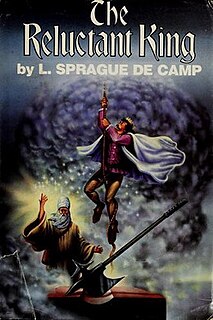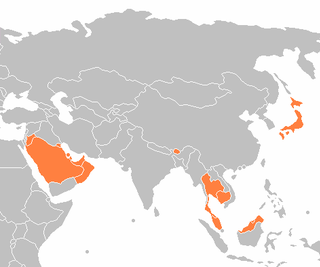
A constitutional monarchy, parliamentary monarchy, or democratic monarchy is a form of monarchy in which the monarch exercises authority in accordance with a written or unwritten constitution. Constitutional monarchies differ from absolute monarchies in that they are bound to exercise powers and authorities within limits prescribed by an established legal framework. Constitutional monarchies range from countries such as Liechtenstein, Monaco, Morocco, Jordan, Kuwait and Bahrain, where the constitution grants substantial discretionary powers to the sovereign, to countries such as the United Kingdom, the Netherlands, Spain, Belgium, Sweden, Malaysia and Japan, where the monarch retains significantly less personal discretion in the exercise of their authority.

Europe is a landmass variously recognised as part of Eurasia or a continent in its own right, located entirely in the Northern Hemisphere and mostly in the Eastern Hemisphere. It comprises the westernmost peninsulas of the continental landmass of Eurasia, it shares the continental landmass of Afro-Eurasia with both Asia and Africa, and is bordered by the Arctic Ocean to the north, the Atlantic Ocean to the west, the Mediterranean Sea to the south and Asia to the east. Europe is commonly considered to be separated from Asia by the watershed of the Ural Mountains, the Ural River, the Caspian Sea, the Greater Caucasus, the Black Sea and the waterways of the Turkish Straits. Although much of this border is over land, Europe is almost always recognised as its own continent because of its great physical size and the weight of its history and traditions.
A monarch is a head of state for life or until abdication, and therefore the head of state of a monarchy. A monarch may exercise the highest authority and power in the state, or others may wield that power on behalf of the monarch. Usually a monarch either personally inherits the lawful right to exercise the state's sovereign rights or is selected by an established process from a family or cohort eligible to provide the nation's monarch. Alternatively, an individual may proclaim themself monarch, which may be backed and legitimated through acclamation, right of conquest or a combination of means.

A monarchy is a form of government in which a person, the monarch, is head of state for life or until abdication. The political legitimacy and authority of the monarch may vary from restricted and largely symbolic, to fully autocratic, and can expand across the domains of the executive, legislative, and judicial. Monarchs can carry various titles such as emperor, empress, king, queen, prince regnant, princess regnant, shahanshah, raja, khan, tsar, sultan, shah, badsha, or pharaoh.

North America is a continent in the Northern Hemisphere and almost entirely within the Western Hemisphere. It can also be described as the northern subcontinent of a single continent, America. It is bordered to the north by the Arctic Ocean, to the east by the Atlantic Ocean, to the southeast by South America and the Caribbean Sea, and to the west and south by the Pacific Ocean. Because it is on the North American Tectonic Plate, Greenland is included as part of North America geographically.

A republic is a form of government in which "supreme power is held by the people and their elected representatives". In republics, the country is considered a "public matter", not the private concern or property of the rulers. The primary positions of power within a republic are attained through democracy or a mix of democracy with oligarchy or autocracy rather than being unalterably occupied by any given family lineage or group. With modern republicanism, it has become the opposing form of government to a monarchy and therefore a modern republic has no monarch as head of state.

South America is a continent entirely in the Western Hemisphere and mostly in the Southern Hemisphere, with a relatively small portion in the Northern Hemisphere. It can also be described as the southern subregion of a single continent called America. The reference to South America instead of other cultural or geographical regions has increased in recent decades due to changing geopolitical dynamics.

The Americas, which are also collectively called America, are a landmass comprising the totality of North and South America. The Americas make up most of the land in Earth's Western Hemisphere and comprise the New World.

Absolute monarchy is a form of monarchy in which the monarch holds supreme autocratic authority, principally not being restricted by written laws, legislature, or unwritten customs. These are often hereditary monarchies. In contrast, in constitutional monarchies, the head of state's authority derives from or is legally bound or restricted by a constitution, legislature or unwritten customs.
The abolition of monarchy involves the ending of monarchical elements in government, usually hereditary.

The "New World" is a term for the majority of Earth's Western Hemisphere, specifically the Americas. The term gained prominence in the early 16th century, during Europe's Age of Discovery, shortly after the Italian explorer Amerigo Vespucci concluded that America represented a new continent, and subsequently published his findings in a pamphlet he titled Mundus Novus. This realization expanded the geographical horizon of classical European geographers, who had thought the world consisted of Africa, Europe, and Asia, collectively now referred to as the Old World, or Afro-Eurasia. The Americas were also referred to as the fourth part of the world.

Monarchy was the prevalent form of government in the history of Europe throughout the Middle Ages, only occasionally competing with communalism, notably in the case of the Maritime republics and the Swiss Confederacy.

The Reluctant King is the overall title of a trilogy of fantasy novels written by L. Sprague de Camp as part of his Novarian series, as well as the 1983 omnibus collection gathering the books together into one volume. The trilogy features de Camp's sword and sorcery hero King Jorian of Xylar, and is composed of The Goblin Tower (1968), The Clocks of Iraz (1971) and The Unbeheaded King (1983). The omnibus was first published in hardcover by Nelson Doubleday in 1983 as an offering for its Science Fiction Book Club, and was reissued in paperback by Baen Books in 1996.

A continent is any of several large landmasses. Generally identified by convention rather than any strict criteria, up to seven geographical regions are commonly regarded as continents. Ordered from largest in area to smallest, these seven regions are: Asia, Africa, North America, South America, Antarctica, Europe, and Australia. Variations with fewer continents may merge some of these, for example some systems include Afro-Eurasia, America or Eurasia as single continents.

There are 12 monarchies in the Americas. Each is a constitutional monarchy, wherein the sovereign inherits his or her office, usually keeping it until death or abdication, and is bound by laws and customs in the exercise of their powers. Nine of these monarchies are independent states; they equally share Queen Elizabeth II, who resides primarily in the United Kingdom, as their respective sovereign, making them part of a global personal union known as the Commonwealth realms. The others are dependencies of three European monarchies. As such, none of the monarchies in the Americas have a permanently residing monarch.

The continent of Australia, sometimes known in technical contexts by the names Sahul, Australia-New Guinea, Australinea, Meganesia, or Papualand to distinguish it from the country of Australia, consists of the landmasses located next to Wallacea. The name "Sahul" takes its name from the Sahul Shelf, which is part of the continental shelf of the Australian continent. The continent includes mainland Australia, Tasmania, the island of New Guinea, the Aru Islands, the Ashmore and Cartier Islands, most of the Coral Sea Islands, and some other offshore continental islands. Situated in the geographical region of Oceania, Australia is the smallest of the seven traditional continents.
There are six monarchies in Oceania; that is: self-governing sovereign states in Oceania where supreme power resides with an individual hereditary head, who is recognised as the head of state. Each is a constitutional monarchy, wherein the sovereign inherits his or her office, usually keeps it until death or abdication, and is bound by laws and customs in the exercise of their powers. Five of these independent states share Queen Elizabeth II as their respective head of state, making them part of a global grouping known as the Commonwealth realms; in addition, all monarchies of Oceania are members of the Commonwealth of Nations. The only sovereign monarchy in Oceania that does not share a monarch with another state is Tonga. Australia and New Zealand have dependencies within the region and outside it, although five non-sovereign constituent monarchs are recognized by New Zealand, Papua New Guinea and France.

Asia has more monarchies than any other continent.













